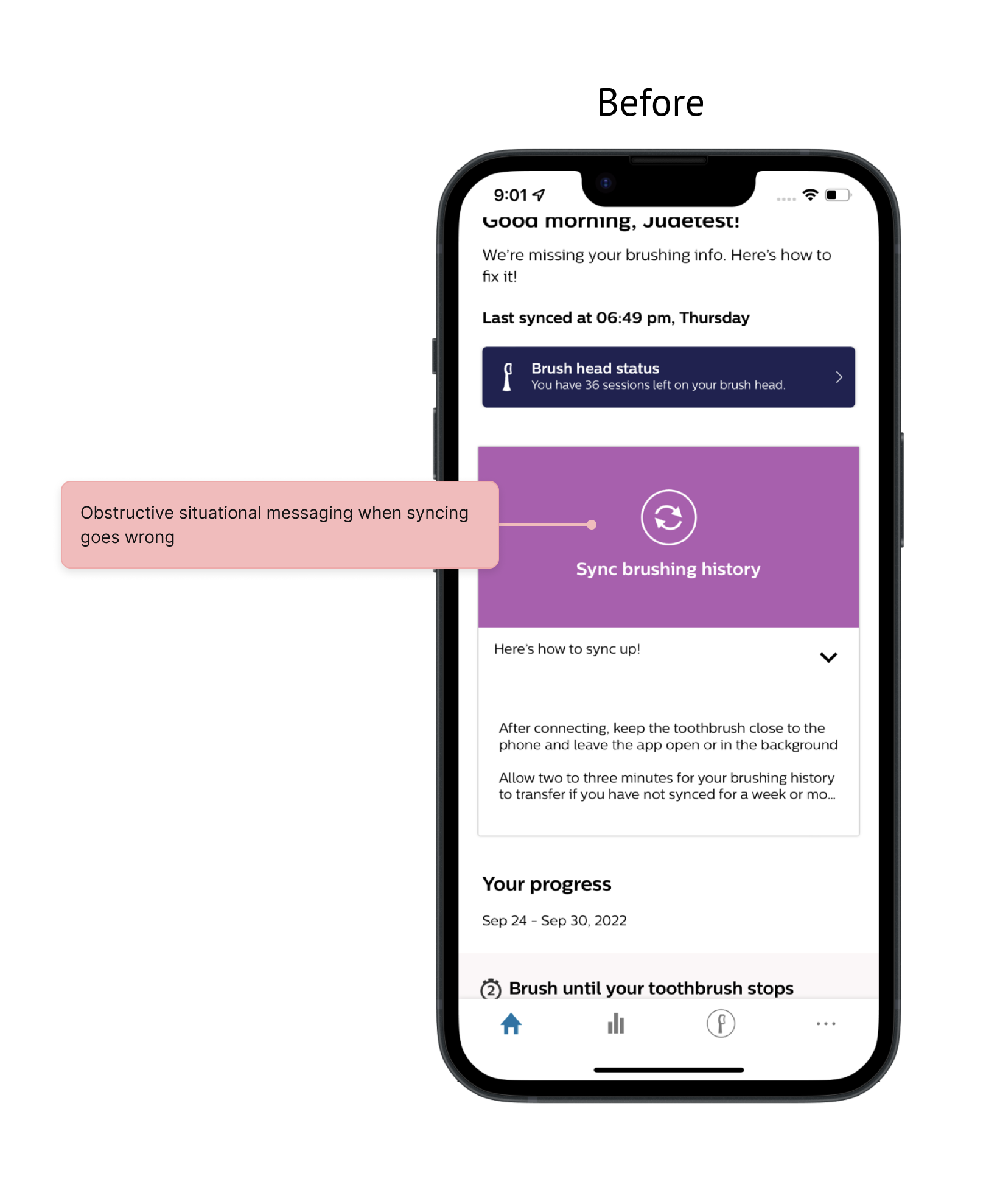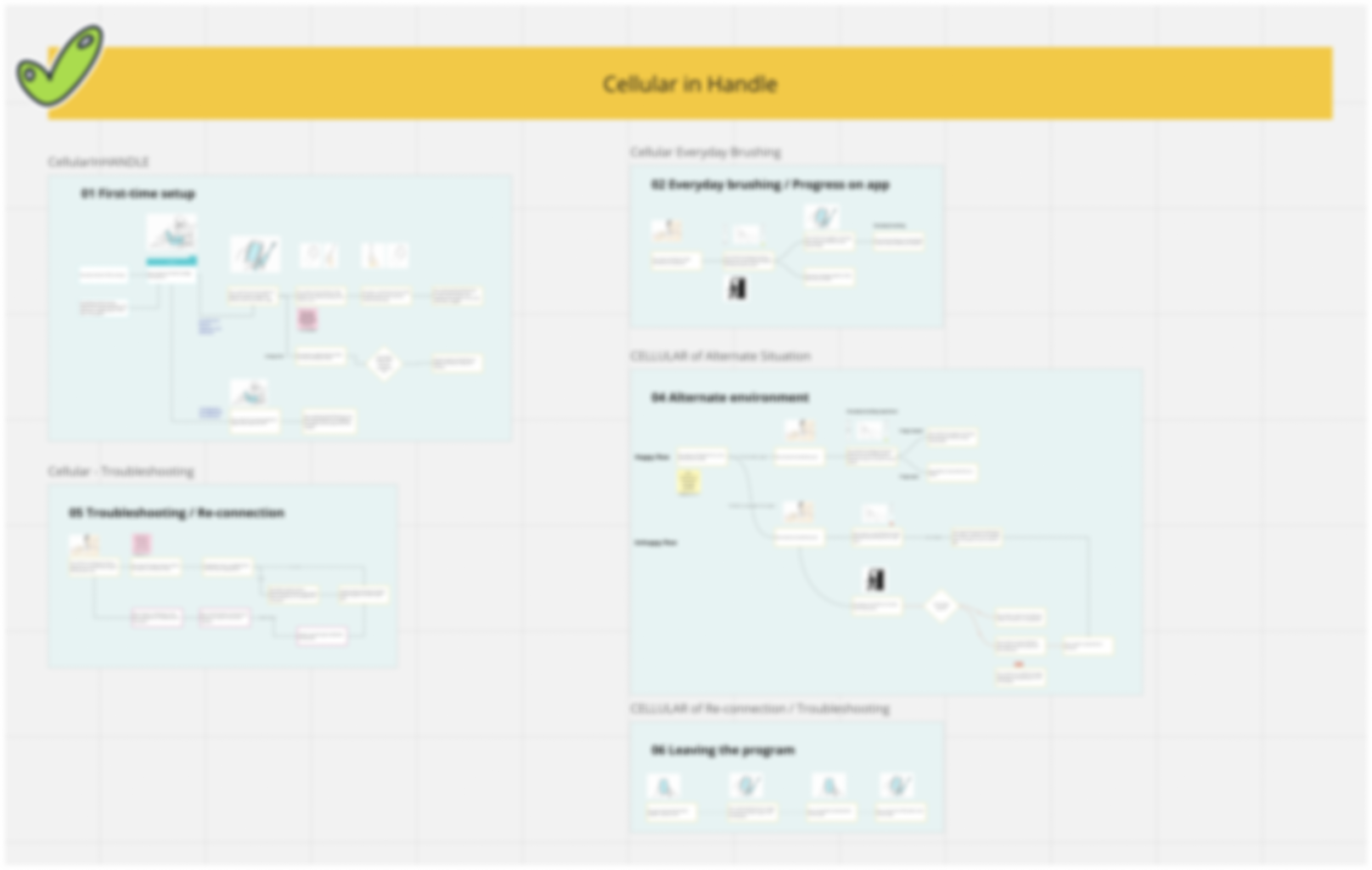
Sonicare Connectivity
Problem
Business Goal
The business goal is to achieve seamless end-to-end data connectivity within the Dental+ program, aiming to meet or exceed an 80%+ data capture and syncing threshold.
Outcome
The smart toothbrush's Bluetooth connectivity is not user-friendly and requires too much manual effort from users to maintain a connection. As a result, the app fails to collect enough data, which is essential for the program to provide personalized recommendations and prove its value to insurance companies and other payers.
Our short-term UX enhancements resulted in a 7% increase in data syncing. A mid-term firmware update enhanced the syncing period. Long-term we kickstarted a new technology adoption process to reach 80% data capture.
At a Glance
Dental+ is a program that Philips Oral Healthcare provides to insurance companies, employers, and governments as a benefit to their members.
My role
0-1 UX designer, service designer, and product strategist.
Team
UX designer (me), product manager, UX researcher, Dental+ business leader, Head of engineering, System engineer, and Product researcher.
Methods
Service design, Interaction design, Product road mapping, Market research, design principles
Timeline
January 2023 - present
Part of it was launched March 2023

The beginning
Transitioning from UI band-aids to real Solutions
Our journey started when we noticed a concerning pattern: deep issues with our software and technology were being incorrectly blamed on poor UI design.
First action
360 View of the Problem
My mission unfolded with a holistic exploration of our existing technology. This meant diving into the nuances of our toothbrush’s capabilities, collaborating with both hardware and software teams, and conducting market research analysis.
Second action
Creating a roadmap
I crafted a strategic plan segmented into manageable stages. I collaborated with the product manager to ensure these immediate, achievable improvements can pave the way for the broader, long-term vision of our IoT technology.
Short-term strategy
On top of BLE technology limitations, we also had no syncing UX and poor troubleshooting UX on the app. I started addressing this by doing the following:
001
Improving sync rate by 7% using interaction design
Process overview
I used double-diamond as a process and dove deeper into user flows, building design principles, creating JTBD, iterating, and testing internally at Philips.
Putting it all together
Objective 1: Provide a toothbrush syncing status
When I open the Dental+ app I want to see my toothbrush status updates, so I can ensure my device and data are up-to-date
Objective 2: Support user with connection failure
After
We used the same interaction as a way to troubleshoot the toothbrush connection issues
When facing connection issues I want clear, step-by-step guidelines, so I can resolve the problem & continue brushing my teeth
Mid-term strategy
In the initial gap analysis, I discovered that our firmware's short BLE advertisement window negatively impacted our sync rate and notification engagement strategy. Additionally, I found that users could only view up-to-date data when waking their toothbrushes, leading to a frustrating experience.
How I solved for it?
I collaborated with the firmware team to extend the advertisement duration by outlining the desired experience. Currently, we are developing this into an internal A/B test to assess its effectiveness.
Increasing sync rate by extending BLE advertising period
Long-term strategy
Given our retention rate drops to 20% by the eighth week, it was critical to consider a long-term alternative technology that reduces the need for constant user input, unlike BLE, to ensure consistent data collection.
Design principles & UX requirements
Concept Evaluation matrix
Example of one technology storyboard
UX flow of one technology concept
Aiming for an 80% DU Data Capture Rate by proposing a new connectivity technology
How I solved for it?
Due to strict confidentiality, I cannot disclose detailed information. However, my significant contribution was in elevating the project's profile, which was initially neglected. I undertook a comprehensive analysis, established critical attractiveness and fit criteria, and formulated essential design principles and user scenarios, which serve as input for our engineering & research team's current milestones.
Key Learnings
Beyond Digital UX Horizons
This project taught me to expand my UX perspective beyond digital, considering the E2E user experience with (IoT) new technology in everyday environments like the bathroom.
Prioritize Problem Understanding
Understanding the problem is the most critical step in the UX process, shaping all following decisions and strategies.
03
Opt for Action over Inaction
I discovered the significance of being proactive and resourceful, choosing action over inaction by leveraging available internal resources for user research













